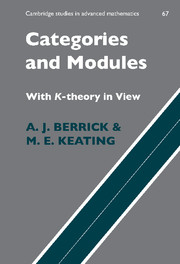1 - Categories
Published online by Cambridge University Press: 12 October 2018
Summary
Category theory provides the language for the discussions in this text and it is also an inescapable foundation for any treatment of K-theory. In this chapter, we set out the fundamental ideas of category theory, and we give a first application of the power of categorical methods. These ideas are introduced in three stages, each of which occupies one section. To start, we define categories themselves. Next, we consider functors, which are the tools for moving between different categories, and then natural transformations, which allow us to compare different functors. In the final, fourth, section of the chapter, we apply these basic notions to investigate universal constructions and universal objects. The idea of ‘universality’ reveals the common properties of apparently diverse objects, such as free modules and free groups, and it provides the framework for many of the definitions and constructions that we make later in this text.
FUNDAMENTAL PROPERTIES OF CATEGORIES
We commence our discussion of the theory of categories with the axiomatic definition of a category, together with a selection of techniques for the manufacture of new categories from old.
Because our main interest in this text is the application of category theory to module theory, many of our illustrations are obtained by considering various types of module. We shall also see some categories based on other algebraic entities such as sets and groups.
The principal innovation in our discussion stems from our need to use both right modules and left modules. Our view is that it is best to write operators opposite scalars as far as is practicable, so that a homomorphism between right modules is to be a left operator, while a homomorphism of left modules is to be a right operator. We also wish to compose homomorphisms in the natural way, by ‘associativity’ - more formal definitions are given below in (1.1.3) and (1.1.4). The consequence is that we obtain two versions of the axiom for the composition of morphisms in an abstract category. Thus we arrive at two kinds of abstract category, a ‘right’ category and a ‘left’ category, which are modeled on the corresponding categories of modules. We call this phenomenon chirality.
- Type
- Chapter
- Information
- Categories and Modules with K-Theory in View , pp. 1 - 67Publisher: Cambridge University PressPrint publication year: 2000



